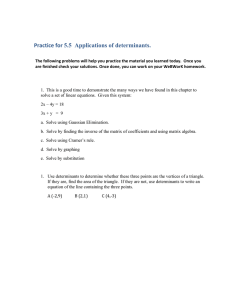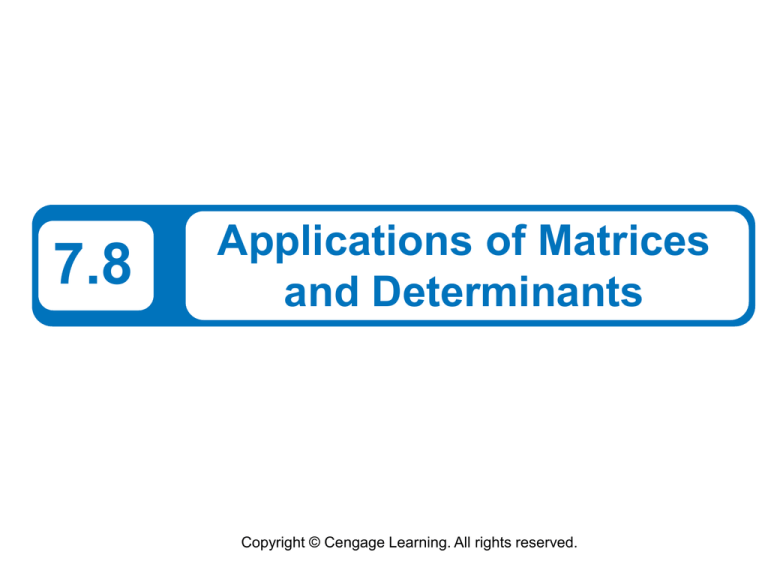
7.8
Applications of Matrices
and Determinants
Copyright © Cengage Learning. All rights reserved.
What You Should Learn
•
•
•
•
Use determinants to find areas of triangles.
Use determinants to decide whether points are
collinear.
Use Cramer’s Rule to solve systems of linear
equations.
Use matrices to encode and decode messages.
2
Area of a Triangle
3
Area of a Triangle
In this section, you will study some additional applications
of matrices and determinants.
The first involves a formula for finding the area of a triangle
whose vertices are given by three points on a rectangular
coordinate system.
4
Example 1 – Finding the Area of a Triangle
Find the area of the triangle whose vertices are (1, 0),
(2, 2), and (4, 3) as shown in Figure 7.28.
Figure 7.28
5
Example 1 – Solution
Begin by letting (x1, y1) = (1, 0),
(x2, y2) = (2, 2), and
(x3, y3) = (4, 3).
Then, to find the area of the triangle, evaluate the
determinant.
= 1(–1)2
+ 0(–1)3
+ 1 (–1)4
6
Example 1 – Solution
cont’d
= 1(–1) + 0 + 1(–2)
= –3
Using this value, you can conclude that the area of the
triangle is
Area
(–3)
square units.
7
Collinear Points
8
Collinear Points
What if the three points in Example 1 had been on the
same line?
What would have happened had the area formula been
applied to three such points? The answer is that the
determinant would have been zero.
Consider, for instance, the three
collinear points (0, 1), (2, 2) and
(4, 3) as shown in Figure 7.29.
Figure 7.29
9
Example 2 – Testing for Collinear Points
Determine whether the points
(–2, –2), (1, 1), and (7, 5)
are collinear. (See Figure 7.30.)
Figure 7.30
10
Example 2 – Solution
Begin by letting (x1, y1) = (–2, –2),
(x2, y2) = (1, 1), and
(x3, y3) = (7, 5).
11
Example 2 – Solution
cont’d
= –2(–4) + 2(–6) + 1(–2)
= –6.
Because the value of this determinant is not zero, you can
conclude that the three points are not collinear.
12
Cramer’s Rule
13
Cramer’s Rule
So far, you have studied three methods for solving a
system of linear equations: substitution, elimination with
equations, and elimination with matrices.
You will now study one more method, Cramer’s Rule,
named after Gabriel Cramer (1704–1752).
This rule uses determinants to write the solution of a
system of linear equations.
Read slides #15&16 so that slide #17 makes sense, but do
not copy them down.
14
Cramer’s Rule
Cramer’s rule states that the system
a1x + b1y = c1
a2x + b2y = c2
has a solution
and
provided that
a1b2 – a2b1 = 0.
15
Cramer’s Rule
Each numerator and denominator in this solution can be
expressed as a determinant, as follows.
16
Cramer’s Rule
Relative to the original system, the denominators of and
are simply the determinant of the coefficient matrix of the
system.
This determinant is denoted by D.
The numerators of and are denoted by Dx and Dy,
respectively.
17
Cramer’s Rule
They are formed by using the column of constants as
replacements for the coefficients of x and y as follows.
Coefficient
Matrix
D
Dx
Dy
18
Cramer’s Rule
For example, given the system
2x – 5y = 3
– 4x + 3y = 8
the coefficient matrix, D, Dx, and Dy are as follows.
Coefficient
Matrix
D
Dx
Dy
19
Cramer’s Rule
20
Example 3 – Using Cramer’s Rule for a 2 2 System
Use Cramer’s Rule to solve the system
4x – 2y = 10
3x – 5y = 11
Solution:
To begin, find the determinant of the coefficient matrix.
D=
= –20 – (–6)
= –14
21
Example 3 – Solution
cont’d
Because this determinant is not zero, apply Cramer’s Rule.
22
Example 3 – Solution
cont’d
= –1
So, the solution is x = 2 and y = –1.
23
Cryptography
24
Cryptography
A cryptogram is a message written according to a secret
code. (The Greek word kryptos means “hidden.”)
Matrix multiplication can be used to encode and decode
messages.
25
Cryptography
To begin, you need to assign a number to each letter in the
alphabet (with 0 assigned to a blank space), as follows.
26
Cryptography
Then the message is converted to numbers and partitioned
into uncoded row matrices, each having n entries, as
demonstrated in Example 6.
27
Example 6 – Forming Uncoded Row Matrices
Write the uncoded row matrices of dimension 1 3 for the
message
MEET ME MONDAY.
Solution:
Partitioning the message (including blank spaces, but
ignoring punctuation) into groups of three produces the
following uncoded row matrices.
Note that a blank space is used to fill out the last uncoded
row matrix.
28
Cryptography
To encode a message, choose an n n invertible matrix
such as
and multiply the uncoded row matrices by A (on the right)
to obtain coded row matrices. Here is an example.
29

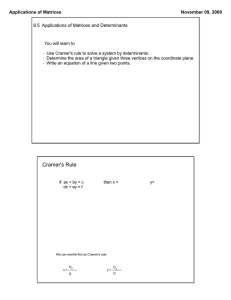
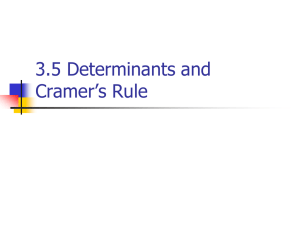
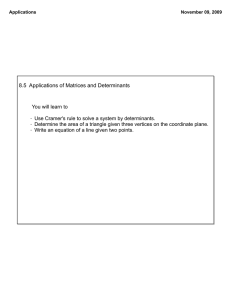
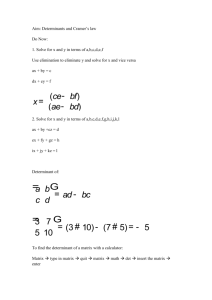
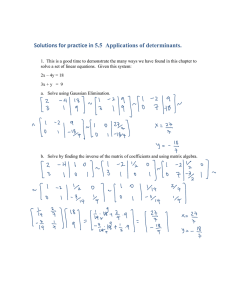
![-----Original Message----- From: Cramer Kim (AC/ETS4.3) [ ]](http://s2.studylib.net/store/data/015586843_1-6b1c4319d0d6d69592003054d378be86-300x300.png)
